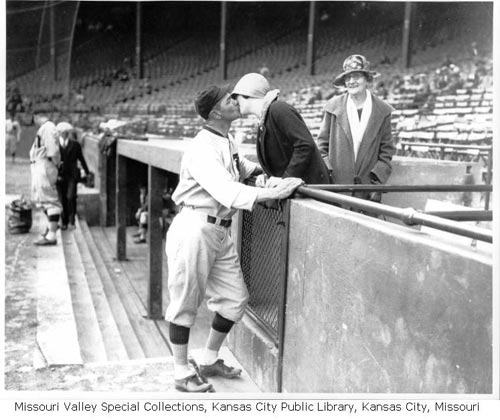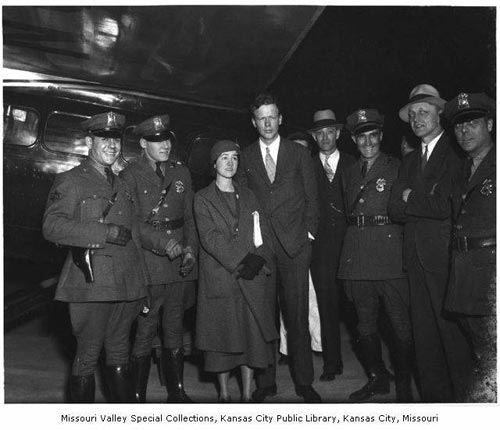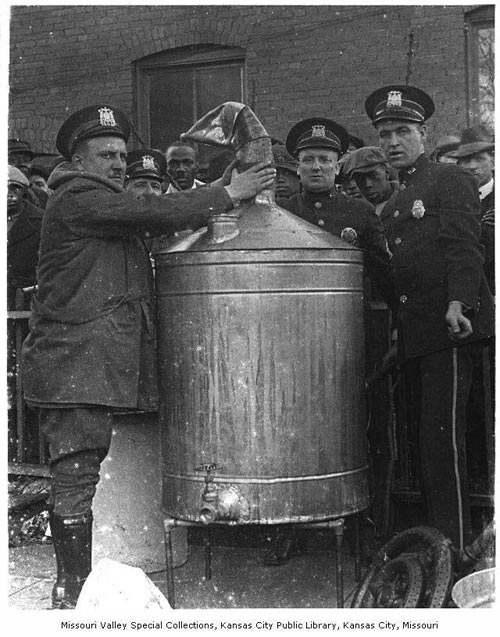In 1997, 84-year-old former freewheeling photographer Jack Wally told the Kansas City Star what it was like shooting for the scrappy, provocative Kansas City Journal-Post in the 1930s: “In those days, you had to decide whether you wanted the prestige of The Star or the fun of working for the Journal.”
A daring photojournalist who infiltrated illegal gambling dens with a makeshift spy camera and once took a freezing, early morning flight in a biplane over a train wreck – 75 feet over a train wreck – Wally embodied the spirit of his paper.
There was an old way of newspaper reporting that was represented by The Star – lots of text, limited use of photos and illustrations, practically no bold headlines. The Journal-Post had a comics section, sensational headlines, an emphasis on crime and scandal, and lots of photos and captions. That was how they tried to appeal to a different audience.

This photo was likely taken inside Muehlebach Field at 22nd Street and Brooklyn Avenue, home of the Kansas City Monarchs and Kansas City Blues baseball teams.
It didn’t work, unfortunately. Declining subscriptions, poor ad sales, and mismanagement plagued the Journal-Post. In its final issue on March 31, 1942, the editors thanked their readers and exited with a bow, writing “We will be going now.”
The paper’s genesis was the result of the merging of two papers. One, The Kansas City Journal, was a Republican publication with roots going back to before the Civil War. The other, The Kansas City Post, was a sensationalistic, Democratic organ that supported the machine politics of “Boss” Tom Pendergast.
Aspiring newspaper man and wealthy manufacturer Walter Dickey had purchased the two papers in hopes of competing with The Star. Though his venture was ultimately unsuccessful, the Journal-Post was the first in the area to reflect changes taking place in media that persist today.
Indeed, anyone who’s perused People or turned on TMZ in the past 10 years will see a lot of common ground between today’s tabloid-style media outlets and the Journal-Post.
Celebrities, crime, sports, and scenes from everyday life are recurring themes in the Library’s collection of more than 300 Journal-Post negatives, donated to the Library in 1998 by Richard Zeldin. The exhibit has narrowed the collection down to some highlights, and viewers will see the larger-than-life juxtaposed with the commonplace.
Commercial aviation was just taking wing in America. In one image, Amelia Earhart lounges in an armchair in the Hotel Baltimore, smiling gamely. Nearby, Charles and Anne Lindbergh are flanked by police and men in suits as they prepare to tour the headquarters of Transcontinental & Western Air (later TWA).

Anne and Charles Lindbergh arrive at Municipal Airport, April 23, 1933.
Crime also had a chokehold on Kansas City. A “wet oasis” during Prohibition, the city was home to a robust mob network that ran illegal distilleries and bootlegging operations.

Kansas City police pose with a confiscated liquor still.
As a railroad hub in an era before everyone flew, Kansas City was a train stop for traveling celebrities on promotional tours, many of whom posed for pictures outside of Union Station.

Comedian and actor Ed Wynn charms a young fan outside Union Station.
The Journal-Post ran many photo contests, inviting readers to submit their favorite snapshots for publication in the paper. Some of the most appealing photos in the exhibit likely came out of these contests. They’re not of famous people or momentous occasions – nothing Jack Wally would’ve gone out of his way for – but they give a peek into what everyday life was like for average citizens, such as these two swimmers enjoying a sunny day at Fairyland Park.

Swimmers on a bench at Crystal Pool in Fairyland Park (7501 Prospect), a popular amusement center in town from 1923-77.
